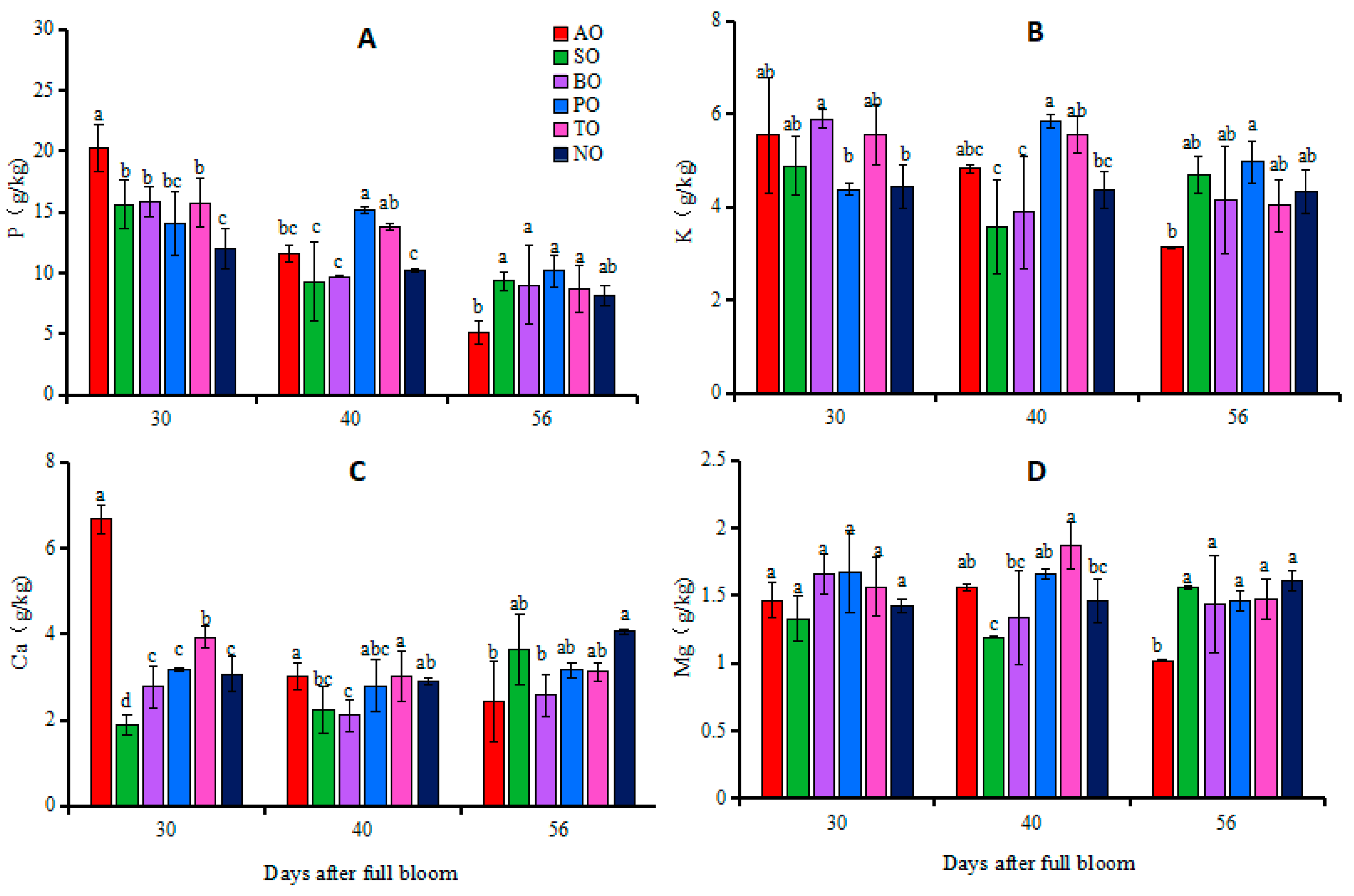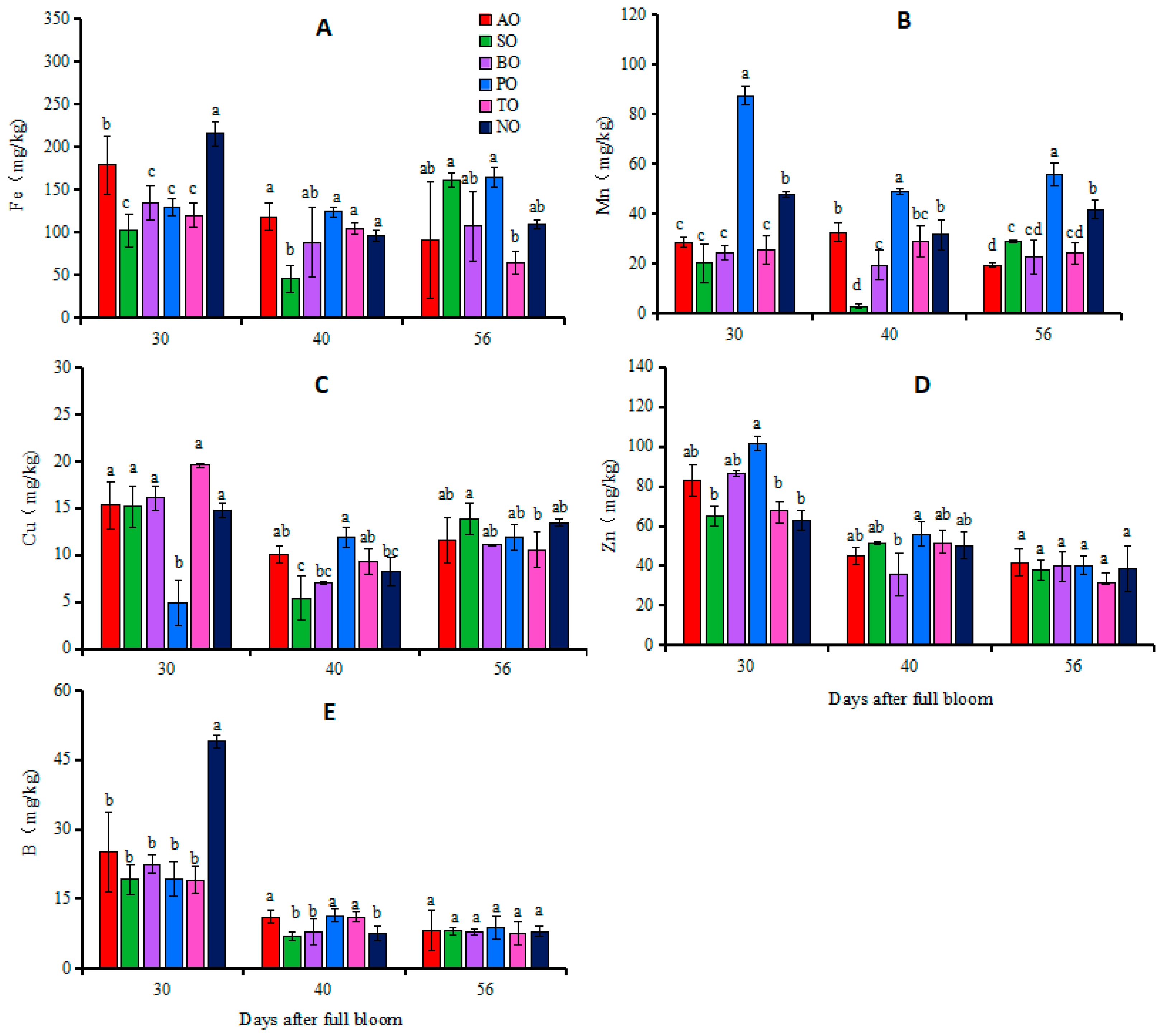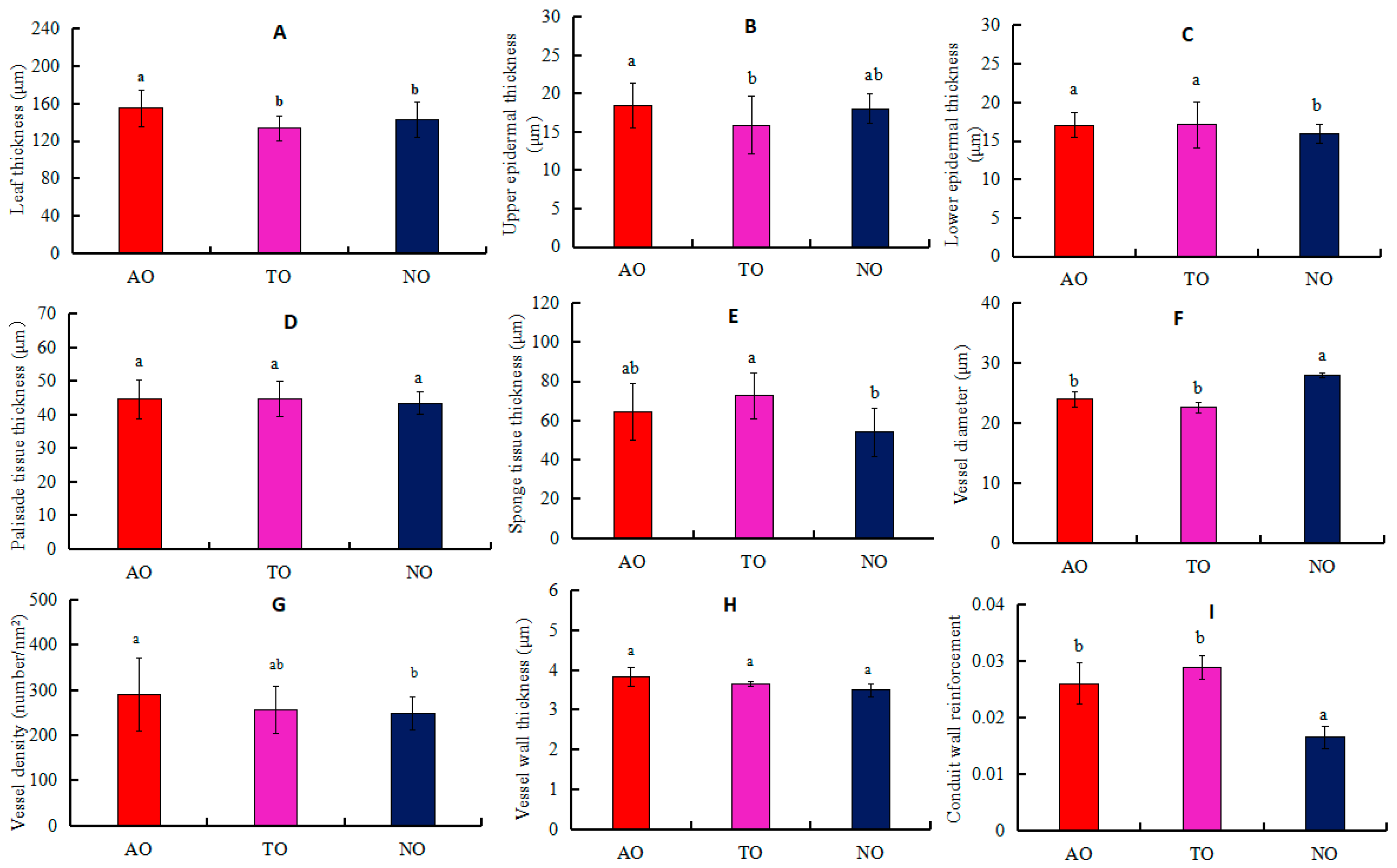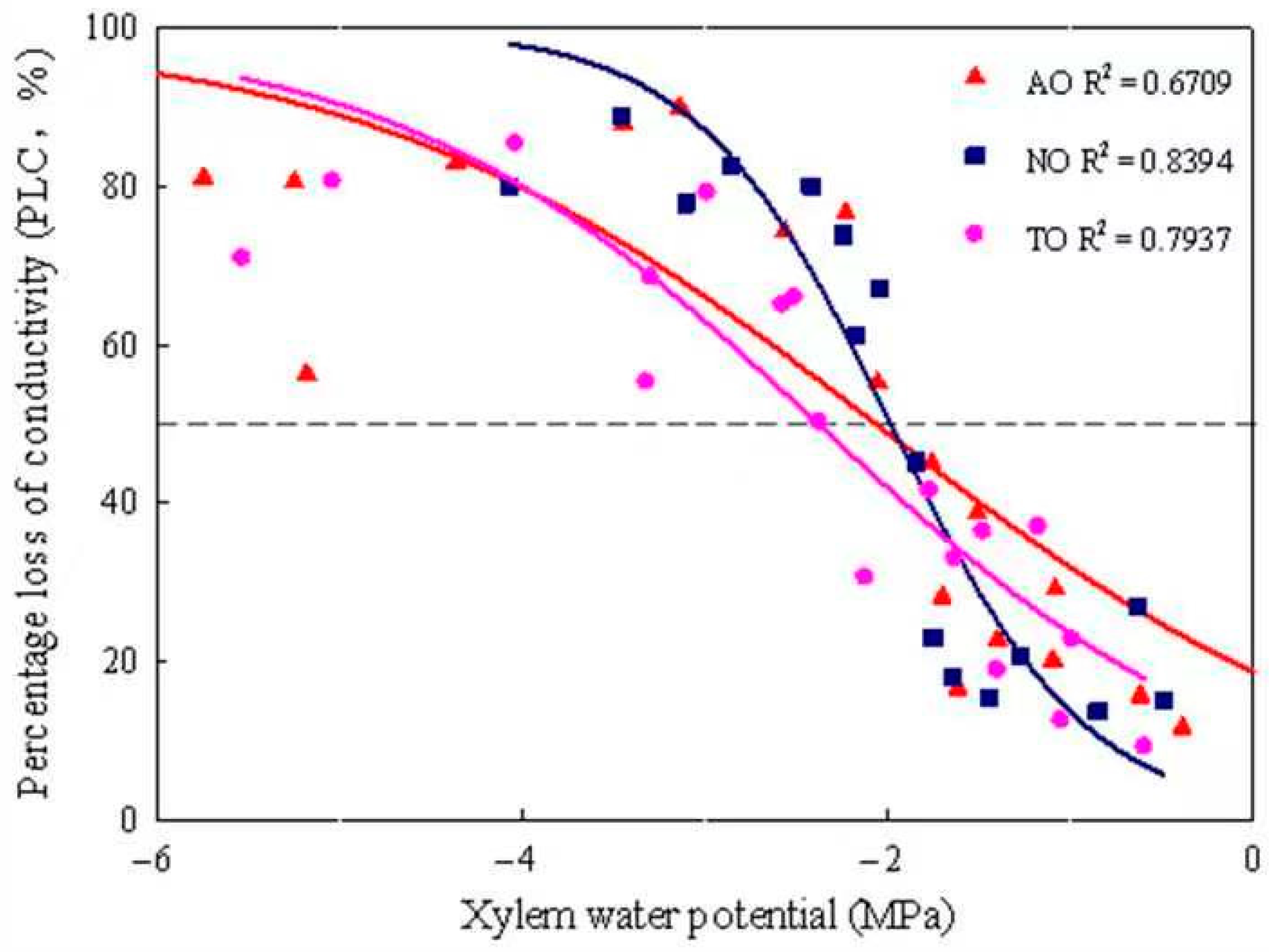A Better Fruit Quality of Grafted Blueberry Than Own-Rooted Blueberry Is Linked to Its Anatomy
Abstract
:1. Introduction
2. Results
2.1. Fruit Quality
2.2. Photosynthesis
2.3. Mineral Nutrients
2.4. Anatomic Structure of Leaves and Stems
2.5. Principal Component Analysis of Anatomic Structure Traits
2.6. Hydraulic Functional Traits of Stems
3. Materials and Methods
3.1. Plant Materials and Soil Properties
3.2. Collection of Fruit, Leaf and Stem Samples
3.3. Fruit Quality Traits
3.4. Fuzzy Comprehensive Evaluation of Fruit Quality Traits
3.5. Photosynthetic Parameters
3.6. Mineral Elements
3.7. Morphological Anatomy of Leaves and Stem Segments
3.8. Stem Hydraulic Conductivity
3.9. Vulnerability Curves
3.10. Data Analysis
4. Discussion
4.1. Rootstocks Affect Scion Fruit Quality
4.2. Rootstocks Affect Scion Anatomical Structure and Drought Resistance
Supplementary Materials
Author Contributions
Funding
Data Availability Statement
Acknowledgments
Conflicts of Interest
References
- Ge, Y.H.; Li, X.; Li, C.Y.; Tang, Q.; Duan, B.; Cheng, Y.; Hou, J.; Li, J. Effect of sodium nitroprusside on antioxidative enzymes and the phenylpropanoid pathway in blueberry fruit. Food Chem. 2019, 295, 607–612. [Google Scholar] [CrossRef]
- Spinardi, A.; Cola, G.; Gardana, C.S.; Mignani, I. Variation of anthocyanin content and profile throughout fruit development and ripening of highbush blueberry cultivars grown at two different altitudes. Front. Plant Sci. 2019, 10, 1045. [Google Scholar] [CrossRef] [PubMed]
- Fallah, A.A.; Sarmast, E.; Jafari, T. Effect of dietary anthocyanins on biomarkers of glycemic control and glucose metabolism: A systematic review and meta-analysis of randomized clinical trials. Food Res. Int. 2020, 137, 109379. [Google Scholar] [CrossRef] [PubMed]
- Han, P.X.; Zhang, B.; Feng, X.Q.; Huang, X.J.; Li, M.M.; Yang, F.W. Nutritional and health functions of blueberry and its development and utilization. Sci. Technol. Food Ind. 2015, 36, 370–375. [Google Scholar] [CrossRef]
- Norberto, S.; Silva, S.; Meireles, M.; Faria, A.; Pintado, M.; Calhau, C. Blueberry anthocyanins in health promotion: A metabolic overview. J. Funct. Foods 2013, 5, 1518–1528. [Google Scholar] [CrossRef]
- Kay, C.D.; Holub, B.J. The effect of wild blueberry (Vaccinium angustifolium) consumption on postprandial serum antioxidant status in human subjects. Br. J. Nutr. 2002, 88, 389–398. [Google Scholar] [CrossRef] [PubMed]
- Xu, C.X.; Ma, Y.P.; Chen, H. Technique of grafting with Wufanshu (Vaccinium bracteatum Thunb.) and the effects on blueberry plant growth and development, fruit yield and quality. Sci. Hortic. 2014, 176, 290–296. [Google Scholar] [CrossRef]
- Han, X.Q.; Zhang, S.; Tong, Y.H.; Gao, X.X. Soil testing and improvement in blueberry orchard. Deciduous Fruits 2020, 52, 67–69. [Google Scholar] [CrossRef]
- Liu, M.Q. Blueberry Propagating and Cultivation Techniques in Zhejiang Province. Ph.D. Thesis, Chinese Academy of Agricultural Sciences, Beijing, China, 2010. [Google Scholar]
- Zhang, Y.; Liu, J.B.; Zhang, X.X. A more drought resistant stem xylem of southern highbush than rabbiteye blueberry is linked to its anatomy. Agronomy 2022, 12, 1244. [Google Scholar] [CrossRef]
- Tomić, J.; Glišić, I.; Milošević, N.; Štampar, F.; Mikulič-Petkovšek, M.; Jakopič, J. Determination of fruit chemical contents of two plum cultivars grafted on four rootstocks. J. Food Compos. Anal. 2022, 105, 103944. [Google Scholar] [CrossRef]
- Valverdi, N.A.; Kalcsits, L. Rootstock affects scion nutrition and fruit quality during establishment and early production of ‘Honeycrisp’ apple. HortScience 2021, 56, 261–269. [Google Scholar] [CrossRef]
- Hu, Z.; Wang, F.; Yu, H. Effects of scion-rootstock interaction on citrus fruit quality related to differentially expressed small RNAs. Sci. Hortic. 2022, 298, 110974. [Google Scholar] [CrossRef]
- Han, Q.Q.; Song, H.F.; Yang, C.C.; Zhang, S.; Korpelainen, H.; Li, C.Y. Integrated DNA methylation, transcriptome and physiological analyses reveal new insights into superiority of poplars formed by interspecific grafting. Tree Physiol. 2022, 42, 1481–1500. [Google Scholar] [CrossRef]
- Yilmaz, B.; Cimen, B.; Incesu, M.; Kamiloglu, M.U.; Yesiloglu, T. Rootstock influences on seasonal changes in leaf physiology and fruit quality of Rio Red grapefruit variety. Appl. Ecol. Environ. Res. 2018, 16, 4065–4080. [Google Scholar] [CrossRef]
- Forcada, C.F.; Reig, G.; Mestre, L.; Mignard, P.; Betrán, J.Á.; Moreno, M.Á. Scion×rootstock response on production, mineral composition and fruit quality under heavy-calcareous soil and hot climate. Agronomy 2020, 10, 1159. [Google Scholar] [CrossRef]
- Bianchi, D.; Ricciardi, V.; Pozzoli, C.; Grossi, D.; Caramanico, L.; Pindo, M.; Stefani, E.; Cestaro, A.; Brancadoro, L.; De Lorenzis, G. Physiological and transcriptomic evaluation of drought effect on own-rooted and grafted grapevine rootstock (1103P and 101-14MGt). Plants 2023, 12, 1080. [Google Scholar] [CrossRef]
- Yang, L.; Xia, L.; Zeng, Y.; Han, Q.; Zhang, S. Grafting enhances plants drought resistance: Current understanding, mechanisms, and future perspectives. Front. Plant Sci. 2022, 13, 1015317. [Google Scholar] [CrossRef]
- Kumar, P.; Rouphael, Y.; Cardarelli, M.; Colla, G. Vegetable grafting as a tool to improve drought resistance and water use efficiency. Front. Plant Sci. 2017, 8, 1130. [Google Scholar] [CrossRef]
- Zhang, C.M.; Shi, S.L.; Liu, Z.; Yang, F.; Zhang, Z.K. Effect of drought stress on the root morphology and anatomical structure of alfalfa (Medicago sativa) varieties with differing drought tolerance. J. Grassl. Sci. 2019, 28, 79–89. [Google Scholar] [CrossRef]
- Heller, C.R.; Nunez, G.H.; Williamson, J.G. Effects of Vaccinium arboreum rootstocks on yield and fruit quality of ‘Patrecia’ southern highbush blueberry grown with minimum soil amendment. J. Am. Pomol. Soc. 2023, 77, 103–109. [Google Scholar]
- Zhu, B.; Guo, P.-P.; Shen, M.; Zhang, Y.; He, F.; Yang, L.; Gao, X.; Hu, Y.; Xiao, J.-X. Transcriptome and metabolome analyses reveal improvement in blueberry fruit quality by interspecifc grafting. Trees 2023, 37, 1–14. [Google Scholar] [CrossRef]
- Li, Y.H. Fuzzy Comprehensive Evaluation of Fruit in Blueberry Cultivars and ISSR for Blueberry Varieties; Anhui Agricultural University: Hefei, China, 2015. [Google Scholar]
- Yan, Q.C.; Jiang, X.M. Determination of total acid and amino nitrogen in fruit juice by continuous titration with acidometer. Shandong Anim. Husb. Vet. 2012, 33, 8–9. [Google Scholar] [CrossRef]
- Zheng, J.P. Determination of vitamin C content in fruits and vegetables by ultraviolet spectrophotometry. Chin. J. Spectrosc. Lab. 2006, 4, 731–735. [Google Scholar] [CrossRef]
- Feng, G.T. Extraction, Purification, Component Identification and Antioxidant of Blueberry Anthocyanins. Master’s Thesis, Guizhou University, Guiyang, China, 2016. [Google Scholar]
- Li, G.Z.; Zhang, Z.C.; Wang, H.X.; Luo, G.H.; Zheng, Y.J. Study on photosynthetic characteristics of four southern highbush blueberry species. North. Hortic. 2014, 9, 15–19. [Google Scholar]
- Scholz, A.; Klepsch, M.; Karimi, Z.; Jansen, S. How to quantify conduits in wood? Front. Plant Sci. 2013, 4, 56. [Google Scholar] [CrossRef]
- Sperry, J.S.; Donnelly, J.R.; Tyree, M.T. A method for measuring hydraulic conductivity and embolism in xylem. Plant Cell Env. 1988, 11, 35–40. [Google Scholar] [CrossRef]
- Greenidge, K.N.H. An approach to the study of vessel length in hardwood species. Am. J. Bot. 1952, 39, 570–574. [Google Scholar] [CrossRef]
- Domec, J.C.; Gartner, B.L. Cavitation and water storage capacity in bole xylem segments of mature and young Douglas-fir trees. Trees 2001, 15, 204–214. [Google Scholar] [CrossRef]
- Zhou, Z.; Yuan, Y.; Wang, K.; Wang, H.J.; Huang, J.Q.; Yu, H.; Cui, X. Rootstock-scion interactions affect fruit flavor in grafted tomato. Hortic. Plant J. 2022, 8, 499–510. [Google Scholar] [CrossRef]
- Miao, L.; Di, Q.; Sun, T.; Li, Y.; Duan, Y.; Wang, J.; Yan, Y.; He, C.; Wang, C.; Yu, X. Integrated metabolome and transcriptome analysis provide insights into the effects of grafting on fruit flavor of cucumber with different rootstocks. Int. J. Mol. Sci. 2019, 20, 3592. [Google Scholar] [CrossRef]
- Yakushiji, H.; Sugiura, H.; Yamasaki, A.; Azuma, A.; Koshita, Y. Tree growth, productivity, and fruit quality of ‘Fuyu’ persimmon trees onto different dwarfing rootstocks. Sci. Hortic. 2021, 278, 109869. [Google Scholar] [CrossRef]
- Zhang, Y.; Xia, G.H.; Ma, K.; Li, G.Y.; Dai, Y.C.; Yan, C.X. Effects of shade on photosynthetic characteristics and chlorophyll fluorescence of Ardisia violacea. Chin. J. Appl. Ecol. 2014, 25, 1940–1948. [Google Scholar] [CrossRef]
- Zhou, D.D.; Liu, D.X.; Li, C.H.; Chen, M.M.; Liu, G.M.; Yang, Q.S.; Li, Y.T. Photosynthetic characteristics and chorophy fluorescence parameters of Celtis sinensis and Ulmus pumila L.seedling under salt stress. Acta Bot. Sin. 2016, 36, 1004–1011. [Google Scholar] [CrossRef]
- Yang, Y.; Yu, L.; Wang, L.; Guo, S. Bottle gourd rootstock-grafting promotes photosynthesis by regulating the stomata and non-stomata performances in leaves of watermelon seedlings under NaCl stress. J. Plant Physiol. 2015, 186, 50–58. [Google Scholar] [CrossRef] [PubMed]
- Liu, Y.-F.; Qi, H.-Y.; Bai, C.-M.; Qi, M.-F.; Xu, C.-Q.; Hao, J.-H.; Li, Y.; Li, T.-L. Grafting helps improve photosynthesis and carbohydrate metabolism in leaves of muskmelon. Int. J. Biol. Sci. 2011, 7, 1161–1170. [Google Scholar] [CrossRef] [PubMed]
- Seiler, G.J.; Campbell, L.G. Genetic variability for mineral concentration in the forage of Jerusalem artichoke cultivars. Euphytica 2006, 150, 281–288. [Google Scholar] [CrossRef]
- Sorgonà, A.; Abenavoli, M.R.; Gringeri, P.G.; Cacco, G. A comparison of nitrogen use efficiency definitions in Citrus rootstocks. Sci. Hortic. 2006, 109, 389–393. [Google Scholar] [CrossRef]
- Zhang, X.Z.; Guo, J.Y.; Wang, Y.Z.; Liu, C.L.; Yuan, Y.B. Effects of different rootstocks on mineral contents and fruit qualities of Fuji apple. J. Plant Nutr. Fertil. 2014, 20, 414–420. [Google Scholar] [CrossRef]
- Zeng, Y.A.; Zhu, Y.L.; Huang, B.J.; Yang, L.F. Effects of Cucurbita ficifolia as rootstock on growth, fruit setting, disease resistance and leaf nutrient element contents in Cucumis sativus. J. Plant Resour. Environ. 2004, 13, 15–19. [Google Scholar] [CrossRef]
- Fazio, G.; Chang, L.; Grusak, M.A.; Robinson, T.L. Apple rootstocks influence mineral nutrient concentration of leaves and fruit. N. Y. Fruit Q. 2015, 23, 11–15. [Google Scholar]
- Zhao, J.; Shen, J.; Chen, C.Y.; Chen, J.F. Effects grafting on photosynthetic characteristics and absorption of mineral elements of cucumber. China Cucurbits Veg. 2014, 27, 10–13. [Google Scholar] [CrossRef]
- Bryson, G.M.; Mills, H.A.; Sasseville, D.N. Plant Analysis Handbook III; Micro-Macro Publishing: Athens, Greece, 2014; p. 351. [Google Scholar]
- Chen, Q.; Liu, W.; Xu, X.B.; Fan, J.S.; Zhang, C.L.; Xiao, J.X. Dynamics of mineral nutrients in leaves of four Vaccinium spp. Cultivars during fruit development period and their correlations. Non-Wood For. Res. 2020, 38, 184–189. [Google Scholar] [CrossRef]
- Liu, W.; Fan, J.S.; Liu, X.M.; Zhang, C.L.; Tu, J.L.; Xiao, J.X. Analysis of fruit quality and leaf mineral nutrients of rabbit-eye blueberries in hills along Yangtze River. J. Anhui Norm. Univ. 2019, 42, 346–350. [Google Scholar] [CrossRef]
- Zhou, Y.; Tian, X.; Yao, J.J.; Zhang, Z.; Wang, Y.; Zhang, X.Z.; Li, W.; Wu, T.; Han, Z.H.; Xu, X.F.; et al. Morphological and photosynthetic responses differ among eight apple scion-rootstock combinations. Sci. Hortic. 2020, 261, 1–13. [Google Scholar] [CrossRef]
- Somkuwae, R.; Taware, P.B.; Bhange, M.A. Influence of different rootstocks on growth, photosynthesis, biochemical composition and nutrient contents in “Fantasy Seedless” grapes. Int. J. Fruit Sci. 2015, 15, 251–266. [Google Scholar] [CrossRef]
- Bhusal, N.; Lee, M.; Lee, H.; Adhikari, A.; Han, A.R.; Han, A.; Kim, H.S. Evaluation of morphological, physiological, and biochemical traits for assessing drought resistance in eleven tree species. Sci. Total Environ. 2021, 779, 146466. [Google Scholar] [CrossRef]
- Khan, A.; Shen, F.; Yang, L.; Xing, W.; Clothier, B. Limited acclimation in leaf morphology and anatomy to experimental drought in temperate forest species. Biology 2022, 11, 1186. [Google Scholar] [CrossRef] [PubMed]
- Jiao, X.; Yu, X.; Ding, J.; Du, Q.; Zhang, J.; Song, X.; Bai, P.; Li, J. Effects of rising VPD on the nutrient uptake, water status and photosynthetic system of tomato plants at different nitrogen applications under low temperature. Sci. Hortic. 2022, 304, 111335. [Google Scholar] [CrossRef]
- Gambetta, G.A.; Herrera, J.C.; Dayer, S.; Feng, Q.; Hochberg, U.; Castellarin, S.D. The physiology of drought stress in grapevine: Towards an integrative definition of drought tolerance. J. Exp. Bot. 2020, 71, 4658–4676. [Google Scholar] [CrossRef] [PubMed]
- Cochard, H.; Badel, E.; Herbette, S.; Delzon, S.; Choat, B.; Jansen, S. Methods for measuring plant vulnerability to cavitation: A critical review. J. Exp. Bot. 2013, 64, 4779–4791. [Google Scholar] [CrossRef]
- Gleason, S.M.; Westoby, M.; Jansen, S.; Choat, B.; Hacke, U.G.; Pratt, R.B.; Bhaskar, R.; Brodribb, T.J.; Bucci, S.J.; Cao, K.F.; et al. Weak trade off between xylem safety and xylem-specific hydraulic efficiency across the world's woody plant species. New Phytol. 2016, 209, 123–136. [Google Scholar] [CrossRef] [PubMed]
- Han, H.; Xi, B.; Wang, Y.; Feng, J.; Li, X.; Tissue, D.T. Lack of phenotypic plasticity in leaf hydraulics for 10 woody species common to urban forests of North China. Tree Physiol. 2022, 42, 1203–1215. [Google Scholar] [CrossRef] [PubMed]
- Tyree, M.T.; Zimmermann, M.H. Xylem Structure and the Ascent of Sap; Springer: Berlin/Heidelberg, Germany, 2022. [Google Scholar] [CrossRef]
- Levionnois, S.; Jansen, S.; Wandji, R.T.; Beauchêne, J.; Ziegler, C.; Coste, S.; Stahl, C.; Delzon, S.; Authier, L.; Heuret, P. Linking drought-induced xylem embolism resistance to wood anatomical traits in Neotropical trees. New Phytol. 2021, 229, 1453–1466. [Google Scholar] [CrossRef] [PubMed]
- Yang, C.J.; Han, Y.Z.; Li, Z.K.; Zhang, D.C.; Wang, H.B.; Li, H.L. Responses of root vessel anatomical structures to drought exposure for two Kobresia species in an alpine meadow habitat in Southeast Tibet. Acta Prataculturae Sin. 2022, 31, 76–87. [Google Scholar] [CrossRef]
- Xu, Q.; Chen, Y.N. Response of anatomy and hydraulic characteristics of xylem stem of Populus euphratica Oliv. to drought stress. Chin. J. Eco-Agric. 2015, 33, 792–800. [Google Scholar] [CrossRef]
- Zhao, X.; Dong, K.H.; Zhang, K.; Zhu, H.S.; Yang, W.D.; Yang, M.H. Drought resistance and root anatomy of Lespedezadavurica (Laxm.) Schindl. J. Grassl. Sci. 2011, 19, 13–19. [Google Scholar] [CrossRef]
- Zhang, Z.; Cao, B.; Gao, S.; Xu, K. Grafting improves tomato drought tolerance through enhancing photosynthetic capacity and reducing ROS accumulation. Protoplasma 2019, 256, 1013–1024. [Google Scholar] [CrossRef]
- Li, R. Relationships between Xylem Structure and Drought Tolerance of Drought Tolerant Tree Species. Master’s Thesis, Northwest Agriculture Forestry University, Xianyang, China, 2016. [Google Scholar]
- Xia, Y.; Li, J.T.; Tang, J.; Tang, M.; Zhang, X.M. Comparative study on embolism vulnerability petals and leaves of camellia japonica and rhododron hybridum. Acta Bot. Sin. 2023, 43, 79–87. [Google Scholar] [CrossRef]
- Ren, Y.Y.; Liu, Y.P.; Wang, N.; Luo, X.Y.; Zhai, X.Q. The relationship between leaf anatomic structure and drought resistance of nine broad leaf plants. J. Nanjing For. Univ. (Nat. Sci. Ed.) 2014, 38, 64–68. [Google Scholar] [CrossRef]
- Yang, Z.P.; Liu, Q.; Li, Z.J. Leaf blade comparative anatomy between the female and the male of Populus euphratica Oliv. Acta Bot. Sin. 2011, 31, 79–83. [Google Scholar]





| Rootstock | Fresh Weight (g/Fruit) | Longitudinal Diameter (mm) | Transverse Diameter (mm) | Fruit Yield (g/Plant) | Total Soluble Solids (%) | Titratable Acidity (%) | Solid:Acid Ratio | Vitamin C (mg/100 g) | Anthocyanin (mg/100 g) |
|---|---|---|---|---|---|---|---|---|---|
| Anna | 1.39 ± 0.33 b | 10.30 ± 0.37 bc | 12.71 ± 0.96 ab | 446.67 ± 31.63 d | 10.37 ± 0.45 d | 0.72 ± 0.12 ab | 16.53 ± 0.23 c | 673.61 ± 1.36 b | 23.35 ± 0.34 f |
| Sharpblue | 1.47 ± 0.05 b | 11.27 ± 1.02 ab | 13.11 ± 0.75 a | 610.33 ± 72.13 c | 11.73 ± 0.49 cd | 0.40 ± 0.19 bc | 23.71 ± 1.78 b | 505.99 ± 0.49 d | 49.88 ± 0.24 d |
| Baldwin | 1.57 ± 0.09 b | 10.64 ± 0.83 ab | 12.52 ± 1.11 ab | 899.67 ± 31.90 ab | 12.97 ± 0.38 bc | 0.61 ± 0.11 ab | 22.13 ± 0.63 b | 510.83 ± 0.38 c | 51.61 ± 0.09 c |
| Plolific | 1.60 ± 0.09 ab | 11.60 ± 0.47 a | 13.77 ± 0.47 a | 956.67 ± 27.10 a | 13.63 ± 0.78 b | 0.39 ± 0.24 bc | 33.83 ± 0.69 a | 356.62 ± 0.51 e | 81.50 ± 1.02 b |
| Tifblue | 1.83 ± 0.02 a | 11.66 ± 0.21 a | 13.41 ± 1.68 a | 966.333 ± 41.68 a | 15.70 ± 0.53 a | 0.20 ± 0.09 c | 35.09 ± 1.03 a | 313.61 ± 0.57 f | 102.68 ± 0.89 a |
| Own-rooted | 1.39 ± 0.03 ab | 9.39 ± 0.41 c | 11.75 ± 1.02 b | 829.67 ± 101.36 b | 8.93 ± 0.57 e | 0.85 ± 0.17 a | 12.97 ± 0.93 d | 675.69 ± 1.51 a | 47.06 ± 0.74 e |
| Grafted and Own-Rooted ‘O’Neal’ | Comprehensive Evaluation Value | Quality Level |
|---|---|---|
| AO | 0.348 | Medium |
| SO | 0.491 | Good |
| BO | 0.501 | Good |
| PO | 0.686 | Excellent |
| TO | 0.891 | Excellent |
| NO | 0.295 | Medium |
| Grafted and Own-Rooted ‘O’Neal’ | Principal Component Score | Synthesis Score | Ranking | |
|---|---|---|---|---|
| P1 | P2 | |||
| AO | −5.56 | −0.65 | −3.98 | 5 |
| SO | 0.20 | −0.73 | 0.04 | 3 |
| BO | −1.23 | −0.56 | −0.93 | 4 |
| PO | 5.12 | −0.29 | 3.54 | 2 |
| TO | 8.27 | 0.90 | 5.90 | 1 |
| NO | −6.91 | 1.33 | −4.66 | 6 |
| Grafted and Own-Rooted ‘O’Neal’ | Net Photosynthetic Rate (Pn)/μmol m−2 s−1 | Transpiration Rate (Tr)/mmol m−2 s−1 | Stomatal Conductance (Gs)/mmol m−2 s−1 | Intercellular CO2 (Ci)/μmol mol−1 |
|---|---|---|---|---|
| AO | 4.82 ± 1.51 c | 0.38 ± 0.26 c | 49.00 ± 14.42 b | 87.23 ± 11.95 d |
| SO | 8.42 ± 1.27 b | 0.49 ± 0.04 bc | 74.67 ± 9.27 b | 109.00 ± 12.77 cd |
| BO | 7.51 ± 1.30 b | 0.50 ± 0.16 bc | 94.00 ± 10.15 ab | 141.67 ± 20.60 c |
| PO | 11.13 ± 1.58 a | 0.79 ± 0.27 b | 140.00 ± 16.29 a | 206.00 ± 11.36 b |
| TO | 11.43 ± 1.80 a | 0.88 ± 0.10 a | 102.33 ± 14.57 ab | 256.67 ± 28.36 a |
| NO | 6.12 ± 1.43 bc | 0.28 ± 0.06 c | 46.33 ± 8.39 b | 124.00 ± 24.00 c |
| Grafted and Own-Rooted ‘O’Neal’ | Principal Component Score | Synthesis Score | Ranking | |||
|---|---|---|---|---|---|---|
| P1 | P2 | P3 | P4 | |||
| NO | −0.40 | −0.34 | −0.02 | 0.04 | −1.13 | 3 |
| AO | −2.98 | 0.99 | 0.83 | 0.04 | −0.70 | 2 |
| TO | 3.38 | 2.42 | −0.80 | 0.04 | 1.84 | 1 |
Disclaimer/Publisher’s Note: The statements, opinions and data contained in all publications are solely those of the individual author(s) and contributor(s) and not of MDPI and/or the editor(s). MDPI and/or the editor(s) disclaim responsibility for any injury to people or property resulting from any ideas, methods, instructions or products referred to in the content. |
© 2024 by the authors. Licensee MDPI, Basel, Switzerland. This article is an open access article distributed under the terms and conditions of the Creative Commons Attribution (CC BY) license (https://creativecommons.org/licenses/by/4.0/).
Share and Cite
Zhu, B.; Guo, P.; Wu, S.; Yang, Q.; He, F.; Gao, X.; Zhang, Y.; Xiao, J. A Better Fruit Quality of Grafted Blueberry Than Own-Rooted Blueberry Is Linked to Its Anatomy. Plants 2024, 13, 625. https://doi.org/10.3390/plants13050625
Zhu B, Guo P, Wu S, Yang Q, He F, Gao X, Zhang Y, Xiao J. A Better Fruit Quality of Grafted Blueberry Than Own-Rooted Blueberry Is Linked to Its Anatomy. Plants. 2024; 13(5):625. https://doi.org/10.3390/plants13050625
Chicago/Turabian StyleZhu, Bo, Peipei Guo, Shuangshuang Wu, Qingjing Yang, Feng He, Xuan Gao, Ya Zhang, and Jiaxin Xiao. 2024. "A Better Fruit Quality of Grafted Blueberry Than Own-Rooted Blueberry Is Linked to Its Anatomy" Plants 13, no. 5: 625. https://doi.org/10.3390/plants13050625




